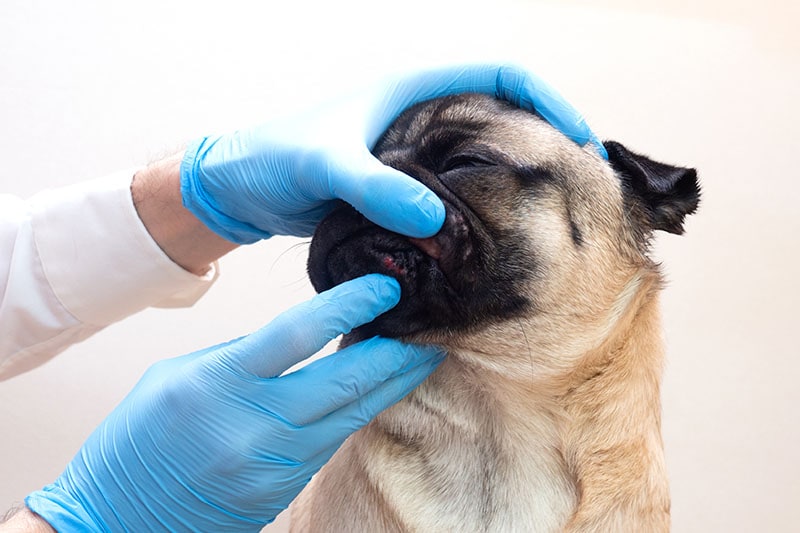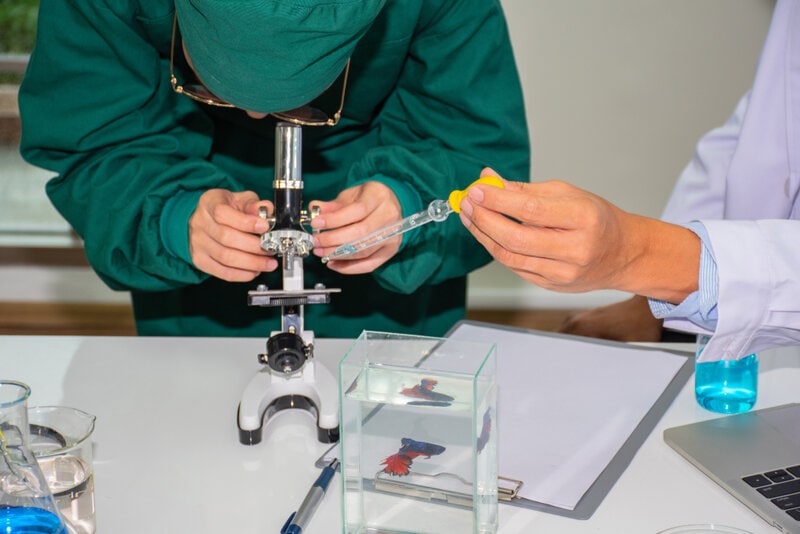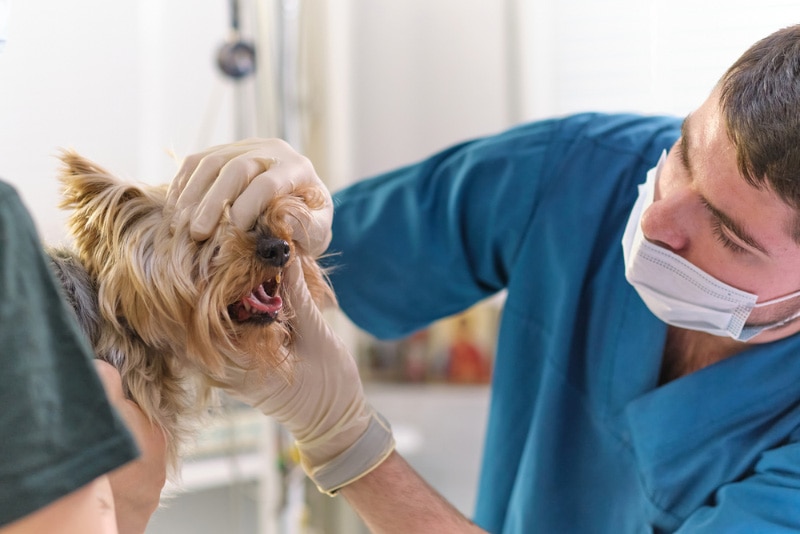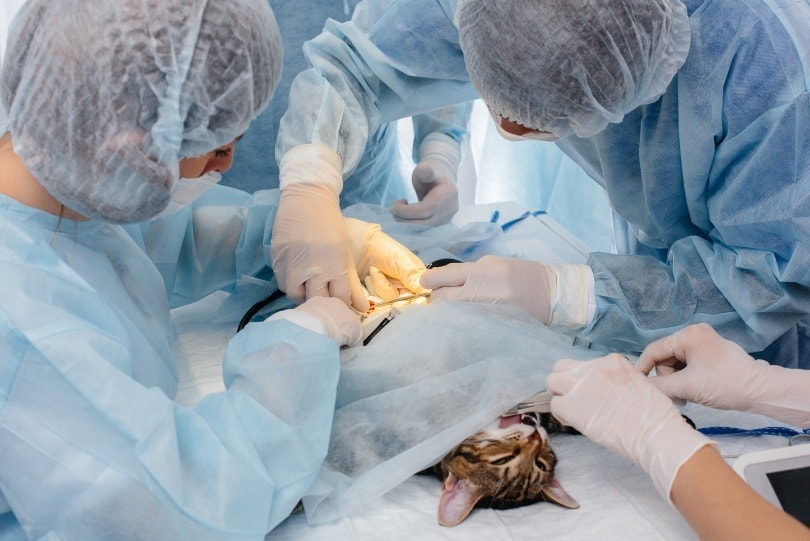Lip Fold Pyoderma in Dogs: Our Vet Explains the Causes, Signs & Treatments
By Dr. Sharon Butzke, DVM (Vet)
Updated on

Click to Skip Ahead
Skin conditions are some of the most common reasons for canine veterinary visits. Pyoderma came in at number five on the 2022 Top Ten list of dog claims submitted to Nationwide Pet Insurance (which insures over a million pets in the United States)1. This article will explain what causes lip fold pyoderma in dogs, how it is treated, and how you can reduce your pup’s risk of developing this condition.
What Is Lip Fold Pyoderma in Dogs?
The word pyoderma, directly translated, means “pus in the skin.” It can be caused by a few different things, but veterinarians often use the term to refer to bacterial skin infections. Pyoderma is classified according to its location on the body and whether the infection is superficial or extends deep into the skin.
Lip fold pyoderma is an infection in the skin folds around the mouth. The most common culprit in dogs is a bacteria called Staphylococcus pseudintermedius. All dogs have bacteria on their skin at any given time.
This is normal and does not typically cause a problem. However, sometimes the number of bacteria gets out of hand, or the skin becomes damaged, allowing bacteria to invade and set up an infection (pyoderma).

What Are the Signs of Lip Fold Pyoderma in Dogs?
Signs of lip fold pyoderma in our canine friends include the following:
- Red, raw skin in the folds around the mouth
- Discharge from the affected skin
- Foul odor coming from the face/mouth
- Tenderness (not wanting their face to be touched)
- Pawing at their mouth or rubbing their face on the ground
Many of these signs can also occur with other medical conditions (e.g., dental disease), so it is crucial to get your pup checked out by a veterinarian to determine the exact cause.
What Are the Causes of Lip Fold Pyoderma in Dogs?
Skin folds, in general, are prone to developing pyoderma because:
- Folds create warm, moist environments, which are perfect growing conditions for bacteria!
- Friction from the folded skin rubbing together can lead to broken skin.
A massive study by the Royal Veterinary College (RVC) found that lip folds were the most common location for skin fold dermatitis (inflammation), which often leads to pyoderma. Other factors that contribute to the development of lip fold pyoderma in dogs include:
1. Anatomy/Breed Predisposition
The RVC study we just mentioned found the highest rates of skin fold dermatitis in purebred brachycephalic (short-nosed, flat-faced) breeds, including English Bulldogs, French Bulldogs, and Pugs. This is not surprising when considering that these dogs are known for their adorable wrinkles!
Breeds that have been shown to be at increased risk specifically for lip fold dermatitis (you can probably guess why) include:
- Saint Bernards
- Basset Hounds
- Spaniels
2. Poor Hygiene
The breeds listed above need extra care to keep their skin folds clean and healthy. Otherwise, bacteria are likely to multiply and invade broken skin, leading to pyoderma.
3. Underlying Health Conditions
Not all predisposed breeds develop skin fold dermatitis or pyoderma, so there must be more to the story. Some medical conditions affect the overall skin integrity and contribute to chronic inflammation. The following are some examples that have been associated with an increased risk of skin fold dermatitis:
- Obesity
- Hypothyroidism
- Hyperadrenocorticism (Cushing’s Disease)
- Parasite infestations (e.g., Demodicosis)
- Allergies
How Is Lip Fold Pyoderma Diagnosed in Dogs?
Most pet parents can probably identify skin fold dermatitis (inflammation) just by looking at their pup’s skin. To confirm pyoderma, your vet will need to collect some samples for cytology. They will rub a cotton-tipped swab in the affected skin folds, roll it on a glass slide, apply special stains, and examine the slide under a microscope to look for bacteria, yeast, and white blood cells.
In some cases, a culture and sensitivity test may be recommended to identify exactly which bacteria are involved and which antibiotics are likely to be the most effective.
Skin biopsies are not generally recommended unless your vet is concerned about the possibility of an immune-mediated condition.

How Do I Care for a Dog With Lip Fold Pyoderma?
Lip fold pyoderma is typically treated with antibacterial cleansers and topical medications. In cases where the infection extends deep into the skin, oral antibiotics may also be needed (often for 4 weeks or more). Your veterinarian may recommend that your pup wears a cone to prevent them from scratching and rubbing the affected skin until it is healed.
It is important only to use products prescribed or recommended by your veterinarian! Products designed for human skin (e.g., baby wipes) are not always appropriate for dogs because their natural skin pH differs from ours.
Can Lip Fold Pyoderma Be Prevented?
It may not be possible to prevent all cases of lip fold pyoderma, but there are certain things you can do to help reduce your pup’s risk (especially if their breed predisposes them to the condition):
- Ask your veterinarian to show you how to properly care for your dog’s skin folds to keep them clean and healthy (including product recommendations)
- Use stainless steel food and water bowls for your pup and wash them with soap and water between every meal
- Help your dog maintain a healthy body weight
- Enlist your vet’s help to screen for and manage other health conditions that can increase the risk of skin fold dermatitis and pyoderma
Frequently Asked Questions
Will My Dog’s Lip Fold Pyoderma Go Away on Its Own?
Lip fold pyoderma will not go away on its own. It is important to enlist your veterinarian’s help to determine an appropriate treatment plan for your dog.

What Will Happen if My Dog’s Lip Fold Pyoderma Is Not Treated?
If lip fold pyoderma is not treated, the affected skin will be an ongoing source of pain for your pup. There is also a risk of the infection traveling into deeper tissues, which can lead to cellulitis or even sepsis (infection in the bloodstream).
Is My Dog’s Lip Fold Pyoderma Contagious?
In most cases, lip fold pyoderma is caused by bacteria that are normally found on your dog’s skin. The risk to people and other pets is generally considered low, but check with your veterinarian, especially if there are young children or immunocompromised individuals in your home.
However, it is still essential to practice good hygiene! Always wash your hands after feeding, petting, or playing with your dog, particularly after giving them medication, cleaning their skin, or applying topical products.
Final Thoughts
Lip fold pyoderma is relatively common in dogs and a good thing to be familiar with if your pup’s breed is predisposed to the condition. Ask your veterinarian to show you how to care for your dog’s skin folds properly. Remember to keep the experience positive because it is going to be part of their lifelong skincare routine!
If you are concerned that your dog may have lip fold pyoderma, schedule an appointment with your veterinarian. Prompt treatment will avoid prolonged discomfort for your pup and help prevent the infection from spreading, which could lead to bigger problems.
See Also:
- Great Tips on How to Train Your Dog to Be Calm in Public
- Best Dog Foods for Pyoderma – Reviews & Top Picks
Featured Image Credit: kobkik, Shutterstock
















